Hood without venting into ventilation: principle of operation, typical diagrams and installation rules
The installation of a hood in the kitchen is determined by the standards for arranging ventilation in a residential area.If it is not possible to connect the device to the general house system, a hood is installed without venting to the ventilation (other names - recirculation, coal).
We will talk about the features and principle of operation of an exhaust device without an air duct. The article we have presented describes in detail the technical characteristics and discusses its pros and cons. For those wishing to install exhaust equipment themselves, an installation manual is provided.
The content of the article:
Typical ventilation schemes in the kitchen
There are two main schemes for kitchen ventilation: natural and forced. In the first case, ventilation is carried out using holes in the walls and open vents, on the one hand, and general house ventilation ducts on the other.
In the second case, air change is carried out mechanically, using the installation of volatile devices. The third, combined option is considered the most successful, in which a natural supply circuit is simultaneously used, according to which air spontaneously enters the room, and forced exhaust through kitchen hoods.
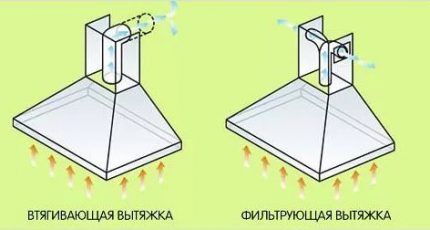
There is a third type - combined devices, which are equipped with double filters and an air duct, and can work either connected to the ventilation shaft or independently.
Natural ventilation has the only advantage: to ensure a comfortable microclimate in the kitchen (as in other rooms) no additional material investments are required.
But it has low efficiency. When cooking on an electric or gas stove, heavy odors quickly spread due to slow air exchange.
Devices for providing forced ventilation are much more productive, but the equipment required to implement the mechanical circuit is dependent on the supply of electricity.
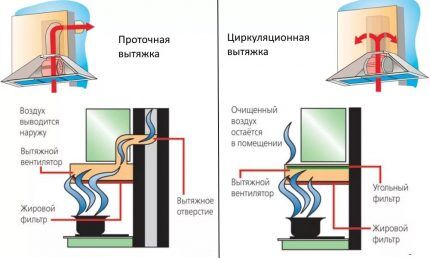
Taking into account these features, a combined scheme is used, combining the operation of exhaust devices and a natural ventilation system.
With typical diagrams and options for ventilation in the kitchen read the article, which we recommend reading.
Types of hoods without venting
If we compare two types of hoods - with and without ventilation outlets - then the first category has more advantages. The main advantage is higher performance, due to which air exchange occurs much faster.
Sometimes a number of technical issues prevent installation exhaust device with ventilation duct, and you have to buy a kitchen hood without outlet and connection to the ventilation, that is, recirculation.
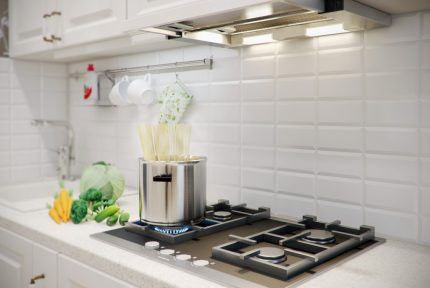
Modern air purification devices differ in their materials, design, and technical capabilities.
The cost of devices directly depends on the technical “stuffing”, quality coal And grease filter elements, design and level of the manufacturer. But you should choose carefully: sometimes models of popular brands are no different from little-known manufacturers, but cost 2-3 times more.
Operating principle of recirculation models
Unlike a hood with a ventilation outlet, coal models do not “pump” air from the room into the ventilation duct, but circulate it and clean it during the filtration process.
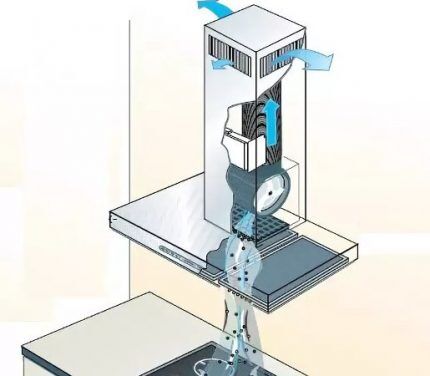
The main working elements of the exhaust system that provide recirculation are the motor and the fan. There are options with 2 motors or with 1 motor, but 2 fans on the sides. They are located inside the housing, above the filters (for dome models) or between them (for built-in varieties).
Performance depends on the power of the engine, which operates on a 220 volt network. This means that before installing the coal model, you need to install a separate socket for connection. Some people mistakenly think that only exhaust hoods require supply ventilation to provide the required volume of fresh air.
In fact and recirculating models need constant updating of the air flow, since air purification with filters does not make it fresh - it simply removes greasy vapors and the smallest particles of dirt. Therefore, natural ventilation also needs to be done daily.
Technical characteristics overview
When purchasing a new hood or replacing an old one, you need to find out the features of specific models. Attention should be paid to both the structure and design, and most importantly, to the technical characteristics on which the efficiency of the ventilation equipment depends.
Device performance calculation
In order to correctly navigate the choice of an effective device, you need to know the exact area of the room. Typically, both the performance and the desired size of the kitchen are indicated in the technical data sheet of the product.
For example, Krona Camilla 600 has a capacity of 550 m³/h (in recirculation mode - 385 m³/h), so it is recommended for servicing rooms up to 11 m² (ceiling height 2.5-2.7 m).
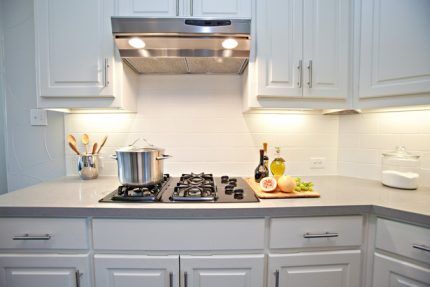
To calculate the performance yourself, you need to multiply the volume of the room by the number of recirculation cycles and take into account the error factor. For the kitchen, the minimum number of recirculation cycles is 12, KP is 1.3. Therefore, to find out the required performance, we consider:
11 x 2.5 x 12 x 1.3 = 429 m³/h
We can conclude that when using the Krona Camilla 600 hood, for sufficient air exchange over an area of 11 m², it is better to use the mode with exhaust ventilation, and use recirculation only as an additional function.
An error factor of 1.3 is usually used when calculating the performance of exhaust hoods; for recirculation models it is slightly higher - 1.7.
Is noise level that important?
The second important parameter that you need to pay attention to is the noise level. If the owners of an apartment or house spend a lot of time in the kitchen, it is advisable to keep it to a minimum. This point is also relevant for those who live in studios where the living room is combined with the kitchen.
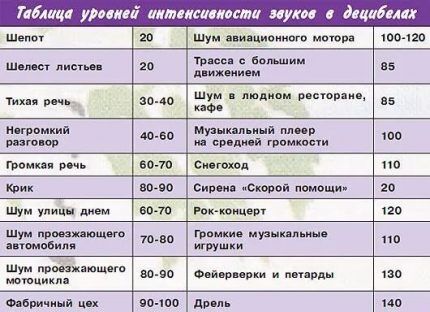
Modern devices operate quite quietly, as they are equipped with special acoustic noise protection. In coal hoods, sounds can be made by a fan, a motor, and air moving inside the structure.
U devices with ventilation outlet Noise often appears due to incorrectly connected air ducts.
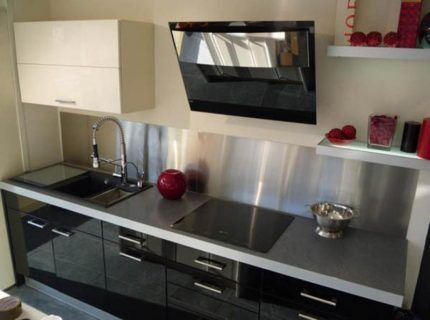
The high cost of the model does not indicate that the hood will work quietly. On the contrary, expensive equipment is more productive than cheap equipment, so it is often devices with a high price tag that create a lot of background sounds - more than 60 dB. Let’s assume that the Neff D55ML66N0 model (36 thousand rubles) has a noise level of 72 dB, and the Elica Hidden HT (51.5 thousand rubles) has a noise level of 62 dB.
Convenient control and adjustment
You have to use the hood every day, so it is advisable to purchase a model with accessible, understandable and convenient controls. All control options can be divided into two large categories: manual and remote.
Manual (or mechanical) has varieties:
- slider (more and less common);
- push-button (the most common type);
Expensive models are equipped with electronic control devices with touch contact panels for transmitting commands.
Models in the mid-price segment are designed traditionally: on the front panel there is a row of buttons with which you can set the desired mode (diversion or recirculation), change the speed, and turn on the backlight.
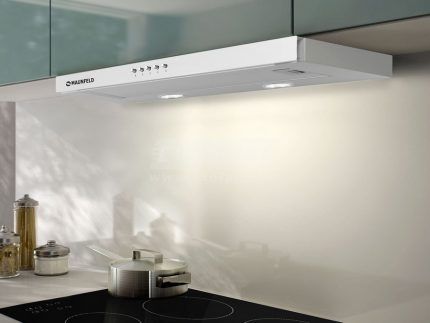
For models with remote control, almost all adjustments are made from the remote control, but the front panel also has buttons or a touch screen for selecting the operating mode. The more convenient the method of operation, the more expensive the equipment.
Important Features and Options
In addition to the basic technical characteristics, there are a number of properties that can become very useful during operation. But if additional functions are not needed, you can save a lot on the purchase, since electronic filling, various modes, and programming increase the cost several times.
The competition of exhaust hoods in the household appliances market is intense, so manufacturers compete to invent new functions. For example, for some models you can regulate not only the intensity of air suction, but also the degree of illumination of the space, and also adjust the speed change in automatic mode.
Guidelines for choosing a hood without communication with ventilation presented in the article, the contents of which we advise you to familiarize yourself with.
Read more about extractor hood filters
Devices that operate without venting into the ventilation shaft are called coal devices due to the presence of carbon filters, which purify the air from specific kitchen odors. Most often these are plastic cassettes of various shapes and filled with activated carbon.
Sometimes pieces of synthetic material, also impregnated with activated carbon, are additionally used.
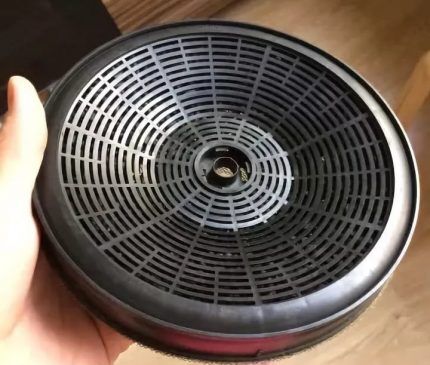
In addition to the carbon filter, there is an anti-grease filter. For built-in models, it is located on the bottom panel and is a metal grille or mesh.
Of course, the mesh cannot catch odors, but it does an excellent job of removing particles of dissolved fat that rise with the steam. In this regard, it is recommended to wash the anti-grease filter approximately once every 30-40 days with non-abrasive agents.
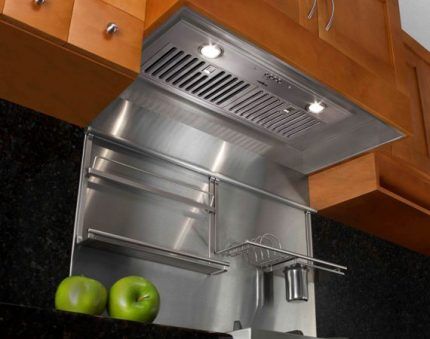
When purchasing replacement products, please note that original and non-original (universal) filters are available for sale. The second group is suitable for many models and is lower in cost than parts produced by the manufacturer.
Carbon filters, as a rule, last for 3-4 months of active use, but the exact data is indicated in the instructions.
Installation rules for the recirculation model
Before installing a hood in the kitchen it is necessary to take measurements, and for a built-in model, prepare a cabinet above the stove. If the equipment is mounted to a ceiling or wall, check the strength of the base.
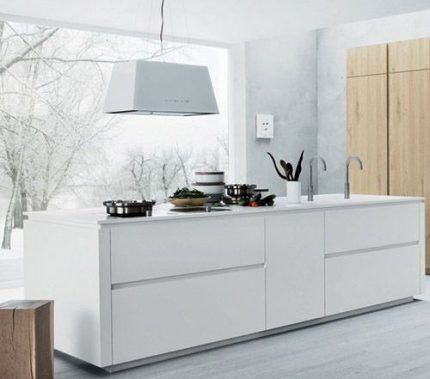
The hood is installed strictly according to the instructions, since functionality largely depends on the quality and installation conditions.
To avoid future problems associated with incorrect installation, you must follow the rules:
- Maintain a distance between the bottom of the hood and the stove. There are clearly defined standards: to a gas stove - 0.75 m, to an electric stove - 0.65 m. But in the instructions you can come across other numbers - 0.6 m and 0.5 m, respectively.
- Prepare a place of the required size in advance. The standard dimensions of built-in appliances are 50 and 60 cm (similar to a stove), but you can find fireplace and island modifications of 80 cm, 90 cm and more.
- Provide (if necessary) free space where the purified air exits.
- Install a separate power point with grounding. Check that the voltage parameters of the hood and the electrical network are the same.
The installation details depend entirely on the type of model. As an example, let's look at the procedure for installing a built-in recirculation hood.
Lastly, insert the metal filters. We check the functionality of the device by connecting it to the power supply. Detailed installation process for a built-in type hood reviewed here. The useful information presented in the article deserves close attention.
To turn on the simplest slider model, just manually pull out the panel with the filter. If necessary, we attach an air duct to transport contaminated air into the ventilation duct.
Conclusions and useful video on the topic
Often, manufacturers and companies that sell products post reviews and installation instructions online so that fewer questions arise and it is more convenient for users to operate the purchased equipment.
Video #1. Installation instructions for Siemens recirculation models:
Video #2. General information on hoods:
Video #3. Comparative review of built-in models and “visors”:
Video #4. What to look for when choosing:
Household hoods without an air duct are an excellent option for providing ventilation in the kitchen if the ventilation duct is not functioning well or there is simply no way to connect to it.
When choosing equipment, be sure to study the technical specifications, and during the installation process follow the manufacturer’s recommendations. A hood installed in accordance with all the rules will provide a pleasant and comfortable atmosphere in the apartment.
Would you like to share useful information about installing and using a ventless hood? Have you ever installed the device yourself? Please write comments in the block below, share useful information and photos on the topic of the article, and ask questions.




We have an old apartment building, there is no access to the ventilation shaft from the kitchen, there is no way to install a hood with a ventilation outlet. For a long time, only ventilation was used in the kitchen. Recently we found a way out of the situation: we purchased a recirculating coal hood. It may not cope as well with air purification as traditional ones, but we are quite happy with it. The air has become much cleaner and the aromas from the kitchen are less intense.
Yes, she copes well, you don’t have a public catering kitchen, you don’t cook at home that often. For an apartment, a recirculating coal hood is enough.
Hello, can you please tell me if I have a suspended ceiling in the kitchen? I can use it? Does the purified air come out of it upward?
I have long dreamed of renovating my kitchen, making the most of the small space of my seven square meters. When selecting furniture, I really liked the kitchen model: despite its compact dimensions, it has excellent capacity.But it is not possible to install a hood with this furniture, since it was not possible to route the pipe into the ventilation hole. We decided to install a recirculating hood. It works well and fits comfortably under a cabinet. The precious place is not lost.
Hello, To write an article, you must be competent in this matter. What does the area of the room have to do with it? THE HOOD WORKS LOCALLY, ONLY TO TAKE AIR FROM THE STOVE, BUT NOT FOR THE WHOLE ROOM! And in this case, your calculations with 12 cycles and coefficients of 1.3 are absolutely unfounded. You confuse people.
If the hood is built into a cabinet without a ventilation outlet, will the hood only operate in recirculation mode? Do I need to make a hole in the cabinet for air to escape?
Is it necessary to install a pipe for air exhaust when installing a hood in a cabinet without venting to the ventilation? Or is it enough to cut holes in the top of the cabinet?